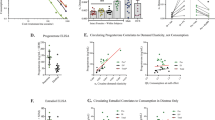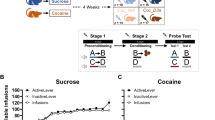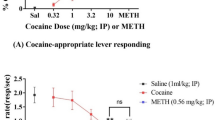Abstract
Fluctuations in ovarian steroid hormones across the menstrual/estrous cycle influence the abuse-related effects of acute cocaine administration in women and chronic cocaine self-administration in rodents, but there have been no comparable studies in non-human primates. The interactions among sex, menstrual cycle phase, and cocaine self-administration (0.0032, 0.01, and 0.032 mg/kg/injection (inj)) under a progressive ratio schedule were investigated in four female and two male cynomolgus monkeys. Females were given unrestricted access to cocaine across 54 menstrual cycles, and males were studied over 23 pseudo-cycles of 30 days duration. Ovulatory cycles were defined by luteal phase elevations in progesterone and 44 cycles were ovulatory. During ovulatory menstrual cycles, females reached significantly higher progressive ratio break points than males at all three unit doses of cocaine (P<0.001). During anovulatory cycles, females also reached significantly higher break points than males for 0.032 mg/kg/inj cocaine (P<0.01). Progressive ratio break points for cocaine (0.01 and 0.032 mg/kg/inj) did not vary significantly as a function of ovarian steroid hormone levels during the follicular and the luteal phase of ovulatory menstrual cycles, or during anovulatory cycles. Progressive ratio break points for 0.0032 mg/kg/inj cocaine were significantly higher during the follicular phase than during the late luteal phase (P<0.05–0.001). There were no systematic changes in progressive ratio break points in male pseudo-cycles. Significant cocaine dose-related sex differences were observed, but no consistent changes in cocaine self-administration as a function of menstrual cycle phase, or levels of estradiol and progesterone, were detected in female cynomolgus monkeys.
Similar content being viewed by others
Log in or create a free account to read this content
Gain free access to this article, as well as selected content from this journal and more on nature.com
or
References
Appt SE (2004). Usefulness of the monkey model to investigate the role of soy in postmenopausal women's health. Ilar J 45: 200–211.
Arnold JM, Roberts DCS (1997). A critique of fixed and progressive ratio schedules used to examine the neural substrates of drug reinforcement. Pharmacol Biochem Behav 57: 441–447.
Barbier O, Belanger A (2003). The cynomolgus monkey (Macaca fascicularis) is the best animal model for the study of steroid glucuronidation. J Steroid Biochem Mol Biol 85: 235–245.
Becker JB (1999). Gender differences in dopaminergic function in striatum and nucleus accumbens. Pharmacol Biochem Behav 64: 803–812.
Becker JB, Molenda H, Hummer DL (2001). Gender differences in the behavioral responses to cocaine and amphetamine. Implications for mechanisms mediating gender differences in drug abuse. Ann NY Acad Sci 937: 172–187.
Bowman BP, Vaughan SR, Walkler QD, Davis SL, Little PJ, Scheffler NM et al (1999). Effects of sex and gonadectomy of cocaine metabolism in the rat. J Pharmacol Exp Ther 290: 1316–1323.
Brebner K, Phelan R, Roberts DCS (2000). Effect of baclofen on cocaine self-administration in rats reinforced under fixed ratio-1 and progressive ratio schedules. Psychopharmacology 148: 314–321.
Caine SB, Bowen CA, Yu G, Zuzga D, Negus SS, Mello NK (2004). Effect of gonadectomy and gonadal hormone replacement on cocaine self-administration in female and male rats. Neuropsychopharmacology 29: 929–942.
Carroll ME, Lynch WJ, Roth ME, Morgan AD, Cosgrove KP (2004). Sex and estrogen influence drug abuse. Trends Pharmacol Sci 25: 273–279.
Channing CP, Fowler S, Engel B, Vitek K (1977). Failure of daily injections of ketamine Hcl to adversely alter menstrual cycle length, blood estrogen and progesterone levels in the rhesus monkey. Proc Soc Exp Biol Med 155: 615–619.
Chen EC, Samuels MH, Luther MF, King TS, Eddy CA, Siler-Khodr TM et al (1998). Cocaine impairs follicular phase pulsatile gonadotropin secretion in rhesus monkeys. J Soc Gynecol Investig 5: 311–316.
Clark UH, Mani SK (1994). Actions of ovarian steroid hormones. In: Knobil E, Neill JD (eds). The Physiology of Reproduction, 2nd edn. Raven Press, Ltd: New York. pp 1011–1059.
Dierschke DJ, Yamaji T, Karsch FJ, Weick RF, Weiss G, Knobil E (1973). Blockade by progesterone of estrogen-induced LH and FSH release in the rhesus monkey. Endocrinology 92: 1496–1501.
Evans SM, Foltin RW (2004). Pharmacokinetics of intravenous cocaine across the menstrual cycle in rhesus monkeys. Neuropsychopharmacology 29: 1889–1900.
Evans SM, Foltin RW (2006). Exogenous progesterone attenuates the subjective effects of smoked cocaine in women, but not in men. Neuropsychopharmacology 31: 659–674.
Evans SM, Haney M, Fischman MW, Foltin RW (1999). Limited sex differences in response to ‘binge’ smoked cocaine use in humans. Neuropsychopharmacology 21: 445–454.
Evans SM, Haney M, Foltin RW (2002). The effects of smoked cocaine during the follicular and luteal phases of the menstrual cycle in women. Psychopharmacology 159: 397–406.
Festa ED, Quinones-Jenab V (2004). Gonadal hormones provide the biological basis for sex differences in behavioral responses to cocaine. Horm Behav 46: 509–519.
Goodman AL, Hodgen GD (1983). The ovarian triad of the primate menstrual cycle. Rec Prog Horm Res 39: 1–67.
Grimm JW, See RE (1996). Cocaine self-administration in ovariectomized rats is predicted by response to novelty, attenuated by 17-β estradiol, and associated with abnormal vaginal cytology. Physiol Behav 61: 755–761.
Haney M, Foltin RW, Fischman M (1998). Effects of pergolide on intravenous cocaine self-administration in men and women. Psychopharmacology 137: 15–24.
Hecht GS, Spear NE, Spear LP (1999). Changes in progressive ratio responding for intravenous cocaine throughout the reproductive process in female rats. Dev Psychobiol 35: 136–145.
Hemby SE, Co C, Koves TR, Smith JE, Dworkin SI (1997). Differences in extracelluar dopamine concentrations in the nucleus accumbens during response-dependent and response-independent cocaine administration in the rat. Psychopharmacology 133: 7–16.
Hodgen GD (1982). The dominant ovarian follicle. Fertil Steril 38: 281–300.
Hu M, Crombag HS, Robinson TE, Becker JB (2004). Biological basis of sex differences in the propensity to self-administer cocaine. Neuropsychopharmacology 29: 81–85.
Jackson LR, Robinson TE, Becker JB (2006). Sex differences and hormonal influences on acquisition of cocaine self-administration in rats. Neuropsychopharmacology 31: 129–138.
Justice AJ, de Wit H (2000a). Acute effects of d-amphetamine during the early and late follicular phases of the menstrual cycle in women. Pharmacol Biochem Behav 66: 509–515.
Justice AJ, de Wit H (2000b). Acute effects of estradiol pretreatment on the response to d-amphetamine in women. Neuroendocrinology 71: 51–59.
Justice AJH, de Wit H (1999). Acute effects of d-amphetamine during the follicular and luteal phases of the menstrual cycle in women. Psychopharmacology 145: 67–75.
Katz JL (1990). Models of relative reinforcing efficacy and their predictive utility. Behav Pharmacol 1: 283–301.
Kosten TR, Kosten TA, McDougle CJ, Hameedi FA, McCance EF, Rosen MI et al (1996). Gender differences in response to intranasal cocaine administration to humans. Biol Psychiatry 39: 147–148.
Kuhar MJ, Ritz MC, Boja JW (1991). The dopamine hypothesis of the reinforcing properties of cocaine. TINS 14: 299–302.
Lukas SE, Sholar M, Lundahl LH, Lamas X, Kouri E, Wines JD et al (1996). Sex differences in plasma cocaine levels and subjective effects after acute cocaine administration in human volunteers. Psychopharmacology 125: 346–354.
Lynch WJ, Arizzi MN, Carroll ME (2000). Effects of sex and the estrous cycle on regulation of intravenously self-administered cocaine in rats. Psychopharmacology 152: 132–139.
Lynch WJ, Roth ME, Carroll ME (2002). Biological basis of sex differences in drug abuse: preclinical and clinical studies. Psychopharmacology 164: 121–137.
Lynch WJ, Roth ME, Mickelberg JL, Carroll ME (2001). Role of estrogen in the acquisition of intravenously self-administered cocaine in female rats. Pharmacol Biochem Behav 68: 641–646.
Lynch WJ, Taylor JR (2004). Sex differences in the behavioral effects of 24-h/day access to cocaine under a discrete trial procedure. Neuropsychopharmacology 29: 943–951.
Lynch WJ, Taylor JR (2005). Decreased motivation following cocaine self-administration under extended access conditions: effects of sex and ovarian hormones. Neuropsychopharmacology 30: 927–935.
Mello NK, Mendelson JH (1997). Cocaine's effects on neuroendocrine systems: clinical and preclinical studies. Special issue on current issues in psychostimulant abuse research. Special Issue on Current Issues in Psychostimulant Abuse Research Pharmacol Biochem Behav 57: 571–599.
Mello NK, Mendelson JH (2002). Cocaine, hormones and behavior. In: Pfaff DW, Arnold AP, Etgen AM, Fahrbach SE, Rubin RT (eds). Hormones, Brain and Behavior. Academic Press: San Diego, CA. pp 665–745.
Mello NK, Mendelson JH, Kelly M, Bowen CA (2000). The effects of cocaine on basal and human chorionic gonadotropin-stimulated ovarian steroid hormones in female rhesus monkeys. J Pharmacol Exp Ther 294: 1137–1145.
Mello NK, Mendelson JH, Kelly M, Diaz-Migoyo N, Sholar JW (1997). The effects of chronic cocaine self-administration on the menstrual cycle in rhesus monkeys. J Pharmacol Exp Ther 281: 70–83.
Mello NK, Mendelson JH, Negus SS, Kelly M, Knudson I, Roth ME (2004). The effects of cocaine on gonadal steroid hormones and LH in male and female rhesus monkeys. Neuropsychopharmacology 29: 2024–2034.
Mendelson JH, Mello NK, Negus SS (1999a). Effects of luteinizing-hormone-releasing-hormone on plasma cocaine levels in rhesus monkeys. J Pharmacol Exp Ther 289: 791–799.
Mendelson JH, Mello NK, Sholar MB, Siegel AJ, Kaufman MJ, Levin JM et al (1999b). Cocaine pharmacokinetics in men and in women during the follicular and luteal phase of the menstrual cycle. Neuropsychopharmacology 21: 294–303.
Munro CA, McCaul ME, Wong DF, Oswald LM, Zhou Y, Brasic J et al (2006). Sex differences in striatal dopamine release in healthy adults. Biol Psychiatry 59: 966–974.
Negus SS, Mello NK (2003). Effects of chronic d-amphetamine treatment on cocaine- and food-maintained responding under a progressive-ratio schedule in rhesus monkeys. Psychopharmacology 167: 324–332.
NIDA (1998). Epidemiologic Trends in Drug Abuse. National Institute on Drug Abuse, NIH: Washington, DC.
ONDCP (1998). National Drug Control Strategy: 1998. Office of National Drug Control Policy, Executive Office of the President, 1999. 138pp.
Potter DA, Moreno A, Luther MF, Eddy CA, Siler-Khodr TM, King TS et al (1998). Effects of follicular-phase cocaine administration on menstrual and ovarian cyclicity in rhesus monkeys. Am J Obstet Gynecol 178: 118–125.
Roberts DCS, Andrews MM, Vickers GJ (1996). Baclofen attenuates the reinforcing effects of cocaine in rats. Neuropsychopharmacology 15: 417–423.
Roberts DSC, Bennett SA, Vickers GJ (1989). The estrous cycle affects cocaine self-administration on a progressive ratio schedule in rats. Psychopharmacology 98: 408–411.
Roth ME, Carroll ME (2004). Sex differences in the escalation of intravenous cocaine intake following long- or short-access to cocaine self-administration. Pharmacol Biochem Behav 78: 199–207.
Roth ME, Negus SS, Knudson IM, Burgess MP, Mello NK (2005). Effects of gender and menstrual cycle phase on food-maintained responding under a progressive-ratio schedule in cynomolgus monkeys. Pharmacol Biochem Behav 82: 735–743.
Rothman RB, Glowa JR (1995). A review of the effects of dopaminergic agents on humans, animals, and drug-seeking behavior, and its implications for medication development: Focus on GBR 12909. Mol Neurobiol 10: 1–19.
Sofuoglu M, Babb DA, Hatsukami DK (2002). Effects of progesterone treatment on smoked cocaine response in women. Pharmacol Biochem Behav 72: 431–435.
Sofuoglu M, Dudish-Poulsen S, Nelson D, Pentel PR, Hatsukami DK (1999). Sex and menstrual cycle differences in the subjective effects from smoked cocaine in humans. Exp Clin Psychopharmacol 7: 274–283.
Sofuoglu M, Mitchell E, Kosten TR (2004). Effects of progesterone treatment on cocaine responses in male and female cocaine users. Pharmacol Biochem Behav 78: 699–705.
Stafford D, Branch MN (1998). Effects of step size and break-point criterion on progressive-ratio performance. J Exp Anal Behav 70: 123–128.
Terner JM, de Wit H (2006). Menstrual cycle phase and responses to drugs of abuse in humans. Drug Alcohol Depend 84: 1–13.
Van Vugt DA, Heisler LE, Reid RL (1992). Progesterone inhibits the estrogen-induced gonadotropin surge in the rhesus monkey independent of endogenous opiates. J Clin Endocrinol Metab 74: 1312–1319.
White TL, Justice AJ, de Wit H (2002). Differential subjective effects of d-amphetamine by gender, hormone levels and menstrual cycle pahse. Pharmacol Biochem Behav 73: 729–741.
Wildt L, Hutchison JS, Marshall G, Pohl CR, Knobil E (1981). On the site of action of progesterone in the blockade of the estradiol-induced gonadotropin discharge in the rhesus monkey. Endocrinology 109: 1293–1294.
Woolverton WL, Johnson KM (1992). Neurobiology of cocaine abuse. Trends Pharmacol Sci 13: 193–200.
Acknowledgements
We thank Kevin Costa, Peter Fivel, Maureen Kelly, Melissa Timm, and Kyle Rheaume for their technical assistance. This research was supported in part by Grants R01 DA14670, K05 DA00101, and K05 DA00064 from the National Institute on Drug Abuse, NIH. Preliminary data were presented at the 68th Annual Meeting of the College on Problems of Drug Dependence in 2006.
Author information
Authors and Affiliations
Corresponding author
Rights and permissions
About this article
Cite this article
Mello, N., Knudson, I. & Mendelson, J. Sex and Menstrual Cycle Effects on Progressive Ratio Measures of Cocaine Self-Administration in Cynomolgus Monkeys. Neuropsychopharmacol 32, 1956–1966 (2007). https://doi.org/10.1038/sj.npp.1301314
Received:
Revised:
Accepted:
Published:
Issue date:
DOI: https://doi.org/10.1038/sj.npp.1301314
Keywords
This article is cited by
-
Effects of early life stress on cocaine self-administration in post-pubertal male and female rhesus macaques
Psychopharmacology (2019)
-
Sex differences in the reduction of impulsive choice (delay discounting) for cocaine in rats with atomoxetine and progesterone
Psychopharmacology (2016)
-
Sex and menstrual cycle effects on chronic oral cocaine self-administration in rhesus monkeys: Effects of a nondrug alternative reward
Psychopharmacology (2016)
-
Fos expression induced by cocaine-conditioned cues in male and female rats
Brain Structure and Function (2014)
-
Dose-dependent effectiveness of wheel running to attenuate cocaine-seeking: impact of sex and estrous cycle in rats
Psychopharmacology (2014)



